Research Area A
Publications 2009
09-Aug-2010
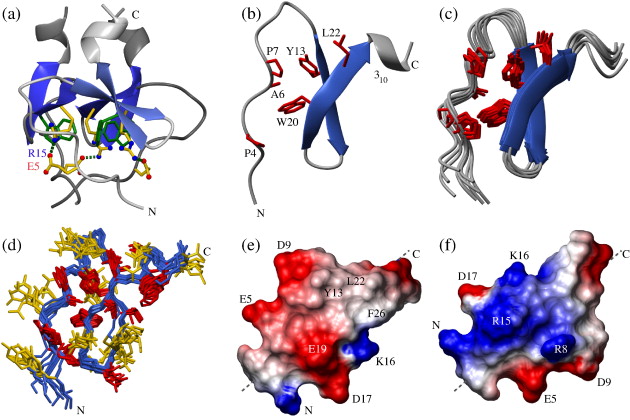
Efficient formation of specific intermolecular interactions is essential for self-assembly of biological structures. The foldon domain is an evolutionarily optimized trimerization module required for assembly of the large, trimeric structural protein fibritin from phage T4. Monomers consisting of the 27 amino acids comprising a single foldon domain subunit ... READ MORE
06-Nov-2009

Three encoded alkyne and alkene amino acids were incorporated into yellow fluorescent protein (YFP) and subsequently glycosylated by using the CuI catalyzed click reaction, as illustrated in the scheme.
... READ MORE05-Oct-2009
We developed a new method for real-time, three-dimensional tracking of fluorescent particles. The instrument is based on a laser-scanning confocal microscope where the focus of the laser beam is scanned or orbited around the particle. Two confocal pinholes are used to simultaneously monitor regions immediately above and below the particle and a feedback loop is used ... READ MORE
25-Sep-2009
The dependence of the pericyclic ring-opening reaction of indolylfulgides and indolylfulgimides on excess energy is investigated by quantum efficiency measurements and by ultrafast spectroscopy. The ring-opening reaction shows a pronounced improvement of reaction efficiency up to a factor of 6, when excess energy is available either by increasing the temperature or ... READ MORE
08-Sep-2009
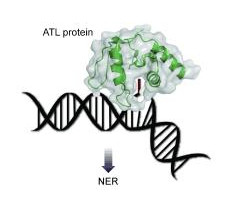
Damage report: Alkyltransferase-like proteins (ATLs) flip DNA lesions out of the DNA duplex but have no catalytic function. They act as recognition proteins that mark DNA lesions and allow repair (see picture; NER=nucleotide excision repair).
... READ MORE31-Aug-2009
UV-light irradiation induces the formation of highly mutagenic lesions in DNA, such as cis-syn cyclobutane pyrimidine dimers (CPD photoproducts), pyrimidine(6-4)pyrimidone photoproducts ((6-4) photoproducts) and their Dewar valence isomers ((Dew) photoproducts). Here we describe the synthesis of defined DNA strands containing these lesions by direct irradiation. We ... READ MORE
06-Aug-2009
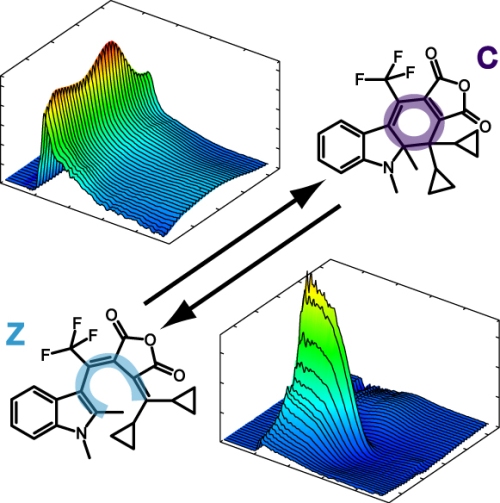
Quantum efficiencies and ultrafast dynamics of the ring-closure and ring-opening reaction of a trifluorinated dicyclopropyl indolylfulgide with improved photostability are investigated by stationary and ultrafast absorption spectroscopy. The ring-closure reaction occurs on the time scale of 200 fs and is found to be temperature independent (T = 287–333 K). ... READ MORE
14-Jul-2009
Archae possess unique biochemical systems quite distinct from the pathways present in eukaryotes and eubacteria. 7,8-Dimethyl-8-hydroxy-5deazaflavin (F0) and F420 are unique deazaflavin-containing coenzyme and methanogenic signature molecules, essential for a variety of biochemical transformations associated with methane biosynthesis and light-dependent DNA repair. ... READ MORE
07-Jul-2009
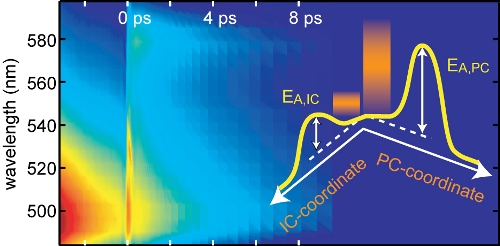
The ring-opening reaction of a trifluorinated indolylfulgide has been studied as a function of temperature and optical pre-excitation where it was found that reaction times decreased as temperature increased from 10.3 ps at 12 °C to 7.6 ps at 60 °C. Simultaneously, the quantum yields for the ring-opening reaction grew from 3.1% (12 °C) to 5.0% (60 °C). When ... READ MORE
05-Jul-2009
The photo-induced rearrangement of 2-benzoyl-3-phenylquinoxaline-1,4-dioxide yielding 1,3-dibenzoylbenzimidazolone (DBBI) is studied by time-resolved fluorescence, UV/vis absorption, and IR spectroscopy. This complex rearrangement occurs on time scales ranging from 0.1 ps up to minutes. Processes within the excited singlet state(s) (0.1–1 ps) are followed by a ... READ MORE
02-Jul-2009
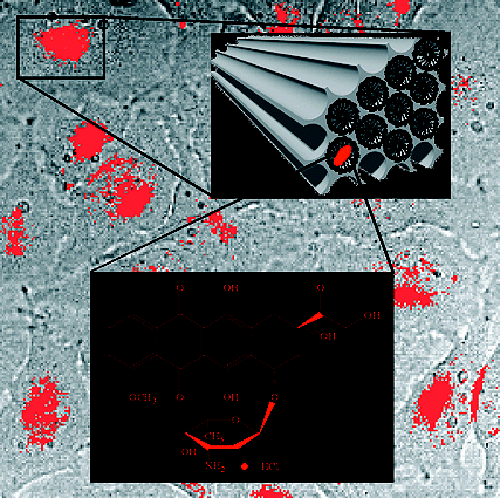
We apply mesoporous thin silica films with nanometer-sized pores as drug carriers and incorporate the widely used anticancer drug Doxorubicin. Through single-molecule based measurements, we gain mechanistic insights into the drug diffusion inside the mesoporous film, which governs the drug-delivery at the target-site. Drug dynamics inside the nanopores is ... READ MORE
12-Jun-2009
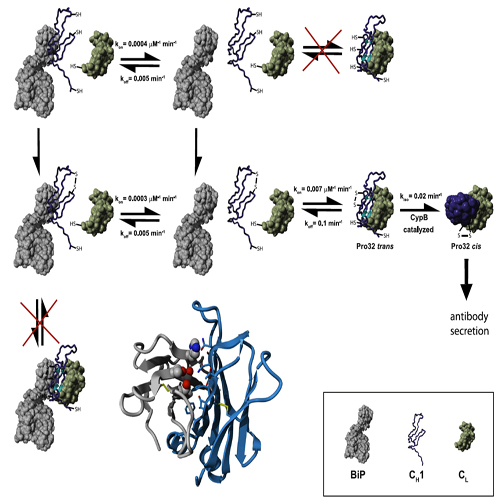
A prerequisite for antibody secretion and function is their assembly into a defined quaternary structure, composed of two heavy and two light chains for IgG. Unassembled heavy chains are actively retained in the endoplasmic reticulum (ER). Here, we show that the CH1 domain of the heavy chain is intrinsically disordered invitro, which sets it apart from other ... READ MORE
30-May-2009
Photolyases repair cytotoxic and mutagenic UV-induced photolesions in DNA by using an amazing light-dependent repair mechanism. It involves light absorption, electron transfer from an excited reduced and deprotonated FADH− to the flipped-out photolesion, followed by the fragmentation of the photolesions. Cryptochromes are highly related proteins that no longer ... READ MORE
27-May-2009
Photochromic pyrans for applications in material and life sciences were synthesized via palladium-mediated cyanation, carbonylation and Sonogashira cross-coupling starting from bromo-substituted naphthopyran 1 and benzopyrans 2a/b. A novel photoswitchable benzopyran-based ω-amino acid 6 for Fmoc-based solid-phase peptide synthesis is presented. The photochromic ... READ MORE
26-May-2009
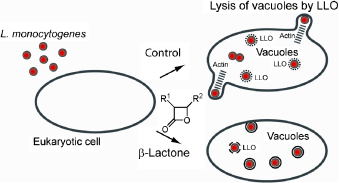
A chemical knockout of the virulence regulator ClpP by β-lactones in Listeria monocytogenes resulted in a reduced production of the major virulence factor listeriolysin O as well as of PI-phospholipase C. This led to a significant decrease in intracellular replication of the pathogen in mouse macrophage cells.
... READ MORE08-May-2009
A new photoinducible single electron donor has been developed, which, when linked to thymidine, is shown to be an efficient ground state reducing agent in DNA; the donor can be activated at wavelengths where standard DNA does not absorb. ... READ MORE
30-Apr-2009
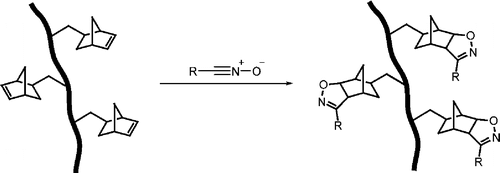
Nitrile oxides react smoothly and rapidly with norbornene-modified DNA in a copper-free click reaction. The reaction allows high density functionalization of oligodeoxyribonucleotides (ODNs) with a large variety of molecules directly on solid supports and even in synthesizers without the need for an additional catalyst.
... READ MORE08-Apr-2009
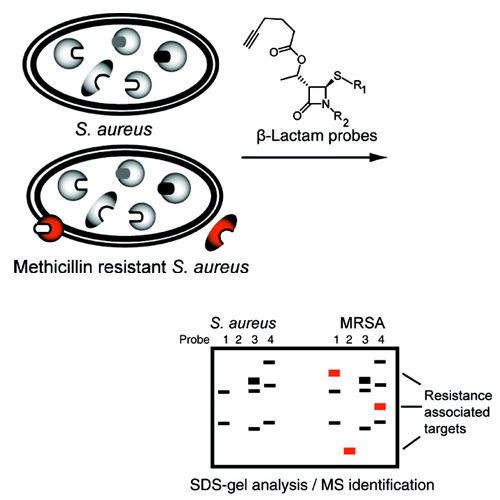
With the development of antibiotic resistant bacterial strains, infectious diseases have become again a life threatening problem. One of the reasons for this dilemma is the limited number and breadth of current therapeutic targets for which several resistance strategies have evolved over time. To identify resistance associated targets and to understand their ... READ MORE
30-Mar-2009
Four newly synthesized Hemithioindigo-based peptide-switches with changing meta/para-substitution-pattern within the stilbene-part of the molecule are characterized with time-resolved absorption spectroscopy. The different substances undergo a light-induced Z/E-isomerization: the reaction proceeds on a picosecond timescale with time constants <50 ps for the Z → ... READ MORE
23-Mar-2009
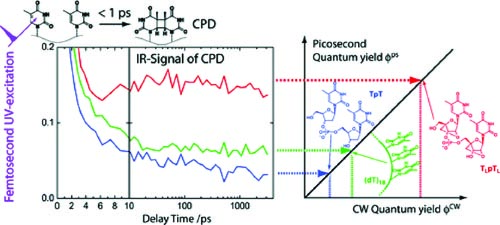
UV-induced formation of cylcobutane pyrimidine dimers (CPD) in all thymine DNA models have been studied by femtosecond IR spectroscopy. CPDs are shown to form within 1 ps during the decay of the initially excited 1π π * state. The quantum yields Dps determined after the 1ππ * decay equal the final yield Dcw. This gives evidence for a predominance of the ... READ MORE
23-Feb-2009
The peripheral antenna complex (LH2) of wild type and mutants of the LH2 α-subunit of purple bacterium Rhodobacter sphaeroides are investigated by transient and stationary absorption spectroscopy. The time for energy transfer from the bacteriochlorophyll (BChl) molecules B800 to B850 is found to depend on the mutation and varies between 0.7 ps for wild type LH2 to ... READ MORE
16-Feb-2009
The cytidine analogue 5-fluoro-2’-deoxycytidine (dCF) is a mechanism- based inhibitor of DNA methyltransferases. We report the synthesis of short 18-mer dsDNA oligomers containing a triplehemimethylated CpG motive as a recognition sequence for the human methyltransferase Dnmt1. The DNA strands carry within these CpG islands dCF building blocks that function as ... READ MORE
Wavelength and solvent independent photochemistry: the electrocyclic ring-closure of indolylfulgides
11-Feb-2009
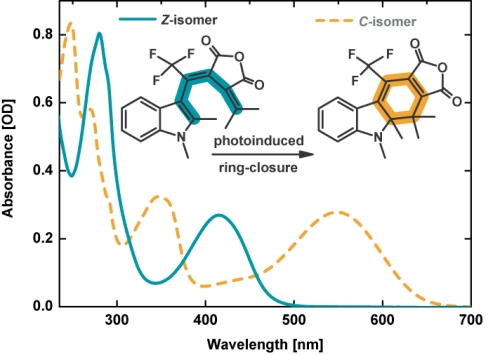
A wavelength and solvent dependent study of a photochromic indolylfulgide is presented. The ring-closure reaction is characterized using stationary and time-resolved spectroscopy with femtosecond time resolution. After excitation into the first excited singlet state (S1) the photoprocesses proceed on ultrafast timescales (0.3–0.45 ps) in both polar and non-polar ... READ MORE
10-Feb-2009
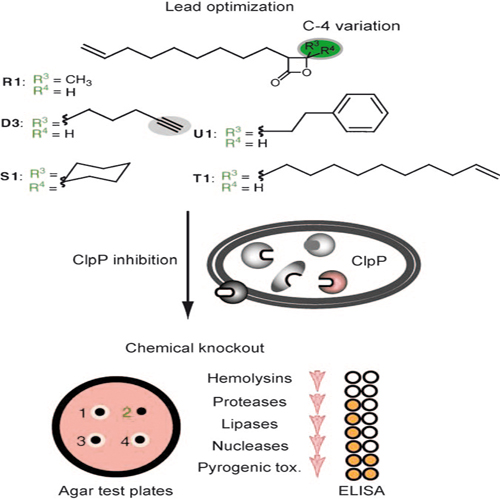
With decreasing efficiency of antibiotic therapies against hospital- and community-acquired bacterial pathogens, the treatment of infectious diseases again represents a tremendous challenge for medicinal research. This challenge seems to be particularly difficult if one considers the sophisticated resistance strategies, which are effective against almost all ... READ MORE
04-Feb-2009

Selective base pairing of the four canonical nucleobases is fundamental for the integrity of the genetic system. Information loss associated with DNA damage is a constant challenge and in response, organisms have evolved specialized defence systems consisting of DNA repair and lesion tolerance. DNA repair requires the action of different lesion recognition ... READ MORE
01-Feb-2009
A molecular model of the acidic compact state of apomyoglobin (A-state) from yellowfin tuna was obtained using molecular dynamics simulations (MD) by calculating multiple trajectories. To cause partial unfolding within a reasonable amount of CPU time, both an acidic environment (pH 3 and 0.15M NaCl) and a temperature jump to 500 K were needed. Twenty-five acidic ... READ MORE
14-Jan-2009
The dynamics of the ring-closure reaction of three different bis(thiophen-3-yl)maleimides are investigated using ultrafast spectroscopy in the visible range. The structures of the molecules differ with respect to substitution of the thiophene ring and the maleimide. The experiments reveal reaction kinetics which point to the population of an excited electronic state ... READ MORE
08-Jan-2009
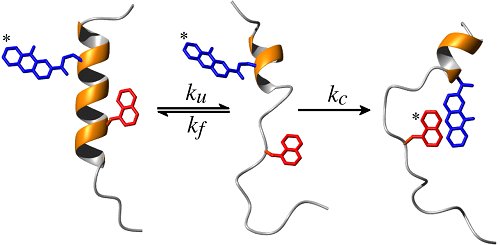
Coupling fast triplet–triplet energy transfer (TTET) between xanthone and naphthylalanine to the helix–coil equilibrium in alanine-based peptides allowed the observation of local equilibrium fluctuations in α-helices on the nanoseconds to microseconds time scale. The experiments revealed faster helix unfolding in the terminal regions compared with the central ... READ MORE
02-Jan-2009
Diffusion of single molecules of a substituted terrylene diimide dye in functionalized mesoporous silica films was monitored by single-molecule fluorescence microscopy. By varying the chemical nature and density of the functional groups, the diffusion dynamics of the dye molecules can be controlled precisely. The picture shows a sketch of a dye molecule in a pore, ... READ MORE
28-Nov-2008

Silver-plated DNA: The deposit of a thin metal layer on biomolecules, such as DNA, requires the formation of small, magic-sized metal nuclei. Through the careful design of a reducing chemical functionality in the form of a dialdehyde, the nucleation process and thus the metallization step can be controlled (see scheme).
... READ MORE14-Nov-2008
An investigation of the precise interactions between damaged DNA and DNA repair enzymes is required in order to understand the lesion recognition step, which is one of the most fundamental processes in DNA repair. Most recently, photoaffinity labeling approaches have enabled the analysis of even transient protein-DNA interactions. Here we report the synthesis and ... READ MORE
We report on the acceleration of the S1 photoreaction combined with the dramatic increase of the photochemical quantum efficiency, when the reaction is directly preceded by another ultrafast photoreaction ... READ MORE


